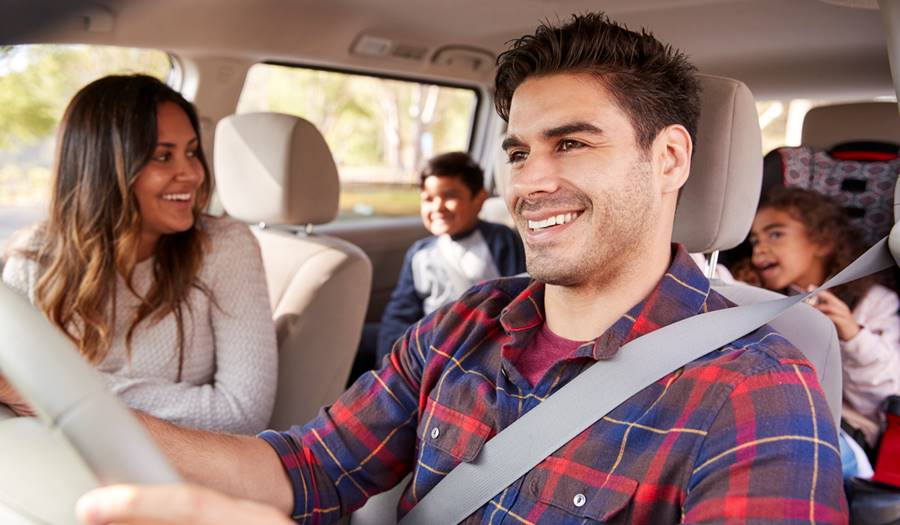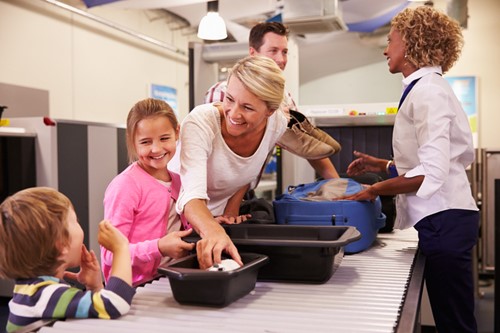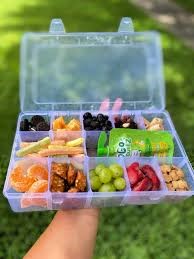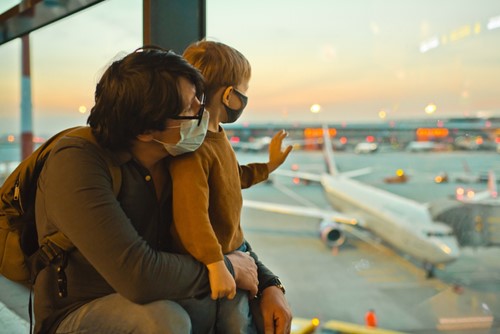
Traveling with Children
2/7/2022
Whether traveling to see family or explore the world, the prospect of traveling with children can be frightening. Traveling can be hectic, exhausting, and usually involves something going wrong! Despite this, involving your child in traveling benefits them in many ways. It helps them expand their world, teaches cultural differences, helps reduce bias, and increases empathy. Travel helps children learn to adapt to change. It helps develop relationships with others and within your family. And for younger children it can help with linguistic development!
GUIDE TO TRAVELING BY AGE
As every age has different needs at home, each age will need different things when traveling to make your trip successful.
BABIES, TODDLERS, AND YOUNG CHILDREN
Traveling with babies is daunting! There is so much to remember and worry about from packing, when to travel, where to stay, and getting through travel days. Let’s break it down.
Planning Flights
If flying with a baby, we recommend waiting until a baby has their first sets of vaccinations. You should also consult with your provider if your baby is premature or has any chronic health issue including chronic lung or heart issues before planning travel by plane.
When booking a flight, you will not be required to purchase a ticket for a child under the age of 2 for most airlines but we recommend booking a seat for your child if possible. It is safer for your child to be in their car seat when flying. Your child will be more comfortable, you will be able to put the child down enabling you to be hands free, and for older mobile babies and toddlers, it allows you to have them restrained on the plane.
Any car seat used on an airplane must be certified for aircraft. You should always check your own car seat or owner’s manual to confirm. A car seat does not count towards luggage. If you chose to travel with your car seat but not use it on the plane, you can check your car seat and stroller at the gate. If you are not traveling with a car seat, make sure you have one available at your destination.
Some planes, particularly those that fly internationally, may have a bassinet in the front row or bulkhead rows. The bassinet can be used for babies under 6 months old or under 20lb. Any other add on product, such as those used to make a bassinet or flat surface between your seat and the seat in front of you, must be approved by your airline. Please check with the airline before using any add on item.
When booking flights, small babies without set schedules tend to be flexible with flight times. Older babies benefit from early morning flights or flights during nap time. For long flights, red eyes can be easier on babies and toddlers who will be fighting jet lag. If your flight is long or not direct, you can also consider breaking up the trip with a night stay in the lay over location or halfway mark.
Planning Lodging
Before booking lodging, read reviews and look at parents guides for recommendations. Consider what type of lodging will work best for your family. This may include staying with friends or families, at hotels or resorts, or renting an apartment or house. Find out if any baby items may be available or included. Some hotels, resorts or rentals have baby equipment available to rent. If not, many larger cities have companies that rent out baby equipment including cribs, car seats, strollers, highchairs, bouncy seats, bathtubs, and toys for daily or weekly fees. They may also rent out childproofing supplies.
Also, consider sleeping arrangements. Will one room work with a small child? Early bedtimes in one room, sometimes means hanging out in the bathroom until they fall asleep! Sometimes renting a house or apartment is a better option when traveling with small children. More room allows you to optimize their sleep as well as your own. You can also be creative with sleeping arrangements. Each one of my own children slept in a portable pack ‘n play in a walk-in closet when small and we traveled. It was dark, quiet, and allowed them private space to sleep or nap.
Consider bringing a darkening tent for your child or room darkening shades as well as having a fan, noise machine, or a noise machine application downloaded to your phone to provide white noise.
Few Days Before Traveling

Before leaving for a trip where you are changing time zones, you can start shifting their sleep schedule 2-3 days before to help the transition. With that said, we traveled to Europe with a 15-month-old and a 5-hour time difference. Because the area we were in had a European-style schedule with later dinner times, we ended up keeping her on her home schedule. That enabled us to enjoy the local culture and schedule, dine later, sleep in, and avoid jet lag when we got home! Before shifting schedules, consider your plans, the time difference before shifting your baby’s schedule.
When traveling with a baby, packing can seem like a Herculean task! Remember, most places you travel you will be able to find forgotten items, even if they aren’t the normal brand or type of item you will use. When packing for the travel portion of your trip, pack a diaper for every hour of travel and lots of wipes for diaper changes and for cleaning up messes on the plane. Pack an extra outfit or two as well as a change of shirt or clothing for any adults in case of vomiting, spitting, or a diaper blow out. For babies who drink formula or are eating solids, bring more food than you think necessary in case of delays. Most airport and airline food is not child or baby friendly so plan on bringing any meals necessary.
Pack toys and distractions for your baby or toddler. Bring a favorite toy and a few favorite books. Toddlers are entertained by surprises, either a new toy, stickers, or new books. Consider packing art supplies, a tablet and headphones for older toddlers and children. A diaper bag may or may not be consider a carryon, check for each airline’s policy. A breast pump is NOT considered a carry on. It is classified as a medical device.
Plan on dressing your baby in layers for the ride as planes can be hot or cold. Soft comfortable clothing is preferred. If your toddler is newly potty trained, consider using a pull up while traveling in case of accidents.
TSA Screening
The first big hurdle of travel days is the TSA screening process. Give yourself lots of extra time at the airport to check in and get through security. Some TSA locations have family lines where you can take your time for this process. During TSA screening you will be allowed to carry a small baby or child. If they are in a stroller or car seat, they will need to be taken out to allow those items to go through the screening process. A baby may be able to stay in a carrier or sling, but you may be required to have increase screening beyond the metal detector. Children will not need to remove shoes during screening.
If a child sets off the metal detector, they will be allowed to go through multiple times. TSA has procedures in place to reduce the likelihood of a child ever needing a pat down as part of the security screening process. Additionally, they can NEVER separate a child from their parents.
TSA security policy limits the amount fluids you can bring on a plane. Breast milk, formula, juice for toddlers, baby foods, and fluid filled teethers are NOT included in the fluid limits set by TSA. Breast milk, in any quantity, can be brought through even if your child is not with you. You are also allowed to have ice packs, freezer packs to keep these items cool. These items do not need to be placed in a quart sized bag. You may be asked to have these items go through the x-ray machine. You can refuse but there is no known harm or issue with x-ray exposure to these items. You may also be asked to put a small amount of the fluid in a separate container for testing. If you refuse either of these screenings, extra steps may be needed to clear these items through security. If your ice packs or freezer packs are not frozen solid, they may also be subject to screening.
Preboarding
After you make it through security, you now need to wait for your flight. Many airports now have play areas to help pass the time. Logan Airport has KidPort play areas in every terminal. This is a great time to let your child walk or run around and get energy out!
Logan Airport, among others, also has nursing rooms that include a sink, changing counter, a seat, and an electrical outlet. Logan Airport also has Mamava Lactation suits in Terminal B, C, and E. These suits are mobile pods where you can privately nurse or pump milk.
Before boarding, make sure you do a last-minute bathroom run for older toddlers and preschoolers and one last diaper change for babies. Make sure to apply a thick layer of diaper cream in case you can’t get up and change a dirty diaper during the flight.
Boarding the Plane
Most airlines allow for pre-boarding with babies and small children. For some airlines this is for children under 2 and some allow for children up to age 6 to board early. I actually recommend NOT boarding early with mobile babies, toddlers, and preschoolers. When you board early, you may spend an extra hour (!!) on the plane before you take off. This means you have an extra hour to entertain your child is a small space, longer if you are delayed after boarding! If you are traveling with two adults, I believe the best method is to have one adult get on with regular boarding and get your seats set up. This means installing any car seat as well as preparing your area so that snacks, toys, and the diaper bag are easily accessible. The other parent or travel partner should stay off the plane and let the children play and stay mobile until boarding is almost complete.
When seating your baby, toddler, or younger child, make sure they are in a window seat or middle seat. Avoiding the aisle keeps them safer as little hands and feet can be injured by the beverage cart. For larger families needing more than one row, consider how to split up seats and responsibilities for caring for children. Some parents prefer to each have a child, some parents prefer to have both children, while the other parent has some downtime. With our family of 5, we chose to have one parent have our two more difficult travelers and the other parent got the easier traveler. We switched roles on the return flights. Discuss ahead of time and plan for what works best for your family.
During take-off and landing, the change in air pressure can bother babies’ and toddlers’ ears. We recommend nursing or giving a baby a bottle or pacifier. Older children should be given a straw or sippy cup. Make sure to bring an empty cup in your diaper bag to be filled with water after passing through security.
If you have your baby in your lap during the flight, you can use a baby carrier to keep them on your chest and allow your hands to be free. Many airlines will not allow you to have the baby in the carrier for take-off or landing. I recommend using a carrier, like a Bjorn or Ergo, that you can keep attached on your body and buckle your baby in and out of easily without needing to stand up or without moving them.
Most parents worry most about their child’s behavior during the flight. What if your child is crying or upset? Stay calm! It happens and although there is always someone mean on the plane who will give you dirty looks, most people, especially other parents, understand that this happens. You may need to get up and walk up and down the aisle or allow them to be mobile on the floor in front of you. Utilize all the distractions and toys you have brought. And if you need screen time to get you through the flight, by all means use it!
Driving Tips
If you are driving to your destination, make sure to take stop every 2 hours to allow a child to get out and move. Plan your trip ahead of time to identify playgrounds close to your route. When we travelled by car when our kids were little, there was a great McDonalds in Connecticut with a huge indoor play area right off 95. We made sure to plan to stop there to let the kids run around and play for a bit.
An adult may want to sit in the back with rear-facing children to help entertain them and offer snacks during the trip. A small child should never eat while strapped in a car seat if not being observed. Make sure to have bottles pre-made and to have extra water and formula or breast milk available. For older children, have pre-filled non-spill cups or water bottles with extra water or drinks available to pour into those cups.
Packing fun and easy to eat snacks like below can be a fun treat in the car (or airplane). You may want to pre-pack lunches to eat when stopped, either picnic style or at a playground, or you may enjoy stopping at a restaurant to stretch out your legs.


For long car trips, bring a small child potty or a portable camping toilet for emergency stops. Wet wipes or an extra roll of toilet paper should be kept with the potty. For children still in diapers, have extra diapers, wipes, and a change of clothing easily accessible.
For older children, plan games or activities to keep them entertained. They can follow the trip on a map or a fun visual aid, learn facts about places you pass through, or listen to songs made by artist from that state. There are also great scavenger hunt games and crosswords made specifically for road trips. Popular games for our family include the license plate game, where we color in a map when we see a license plate from that state and we try to get all 50 states; Round Robin DJ where we each take a turn picking a song, or trivia games. Audio books and podcasts can also be enjoyable to listen to but remember to download these when you have Wi-Fi access. It’s annoying to hear “how much longer” every few minutes. To prevent this, you can create a countdown clock or try celebrating every hour or half hour of the trip by offering a treat or a surprise.
Once You Arrive
Once you arrive, settle into your lodgings. Childproof your room or rooms if needed. Make sure you know local emergency numbers and local hospitals in case of emergency. If you have crossed time zones, make sure to be active outdoors the first day. Exposure to daylight will help you adjust to the new time zone.
Toddlers benefit from lots of outdoor time when traveling. Your itinerary should include time at local parks, open areas, or at the pool when traveling with a toddler. You should also avoid keeping them strapped into a car or stroller all day. They will be miserable, and it will put a damper on your trip. Plan small outings but stay flexible. Also try to keep their schedule as much as possible including mealtimes, naps, and bedtimes.
Traveling with babies and young kids can be challenging. Discuss your expectations before your trip. Discuss whether you may plan for each parent to have some alone or downtime from caring for children. Discuss what part of the trip is most important to have happen and which parts you are willing to miss if needed.
OLDER CHILDREN AND TEENS
Older children and teens are often easier to travel with but still need special considerations.
Planning
When planning a trip, you can include your older child is the planning. Give them choices between activities. Research kid friendly tours and reference review or guides from trusted parenting sources. Teens can take ownership of part of the trip and plan a part of the itinerary for the family.
Often older children and teens aren’t very excited to travel with family. Consider their wants and needs when picking a location. You can also consider traveling with family with same aged cousins or with family friends. For older children, consider allowing them to bring a friend.
Allow an older child or teen to pack their carry-on bag with new books, favorite snacks, an empty water bottle, electronics, and headphones. Make sure all electronics are charged before leaving and consider bringing back up chargers for longer flights. Also make sure to pre-download any entertainment that would normally require internet service to watch or play.
TSA Screening
Children over the age of 12 will need to take off their shoes before passing through security. Prepare your child before the screening process. Let them know all liquids must be 3 ounces or less and placed in a quart-sized bag. All electronics will be placed in a bin and their belongings will go through an x-ray machine. They will be asked to remove shoes, belts, and anything metal. They will then walk through a metal detector. Children will be allowed to go through multiple times if they set it off to avoid a pat-down screening. They can also never be separated from you.
Also advise your child that it is against the law to joke about threats to anyone’s safety. They cannot joke about bombs or guns while at the airport. If they do and they are overheard it can result in removal from the airport, fines, and travel delays.
Boarding
Older children and teens are not allowed to pre-board. Once in their seat, make sure they settle into their seat with everything they need. Make sure they understand the seat belt rules and how to safely stow their belongings. Also explain that they must remain seated until cabin movement is allowed by the pilots and flight attendants.
Booster seats are not allowed to be used on planes, but they can be checked at the gate. Children over 40lb can safely use the seatbelts on the plane without a car seat.
Make sure to pack lots of snacks and food, particularly if you have a picky eater, as plane food is not usually child friendly.
Once You Arrive
Once you arrive at your destination, give your child or teen a chance to explore your lodgings and settle in. Remember to keep your plans flexible. You may be up for a full day of sight-seeing, but your child may need more breaks or chances to relax during your trip.
Trips should be a fun time for family bonding while exploring but a miserable teen can ruin that experience! Allow your teen to sleep in if you can. This may mean planning a morning activity without them and having them join in the afternoon. Also, teens enjoy freedom. If you are in a location where it is safe, allow them some time to explore on their own.

SPECIAL CONSIDERATIONS
Children with Disabilities or Medical Conditions
When traveling with a child with disabilities, planning should start with booking. Before booking, make sure you know what your child is legally entitled to when traveling. Review the Non-discrimination on the Basis of Disability in Air Travel law. When booking flights, let the airline know your child’s needs so you can choose the best seat, arrange for any accommodations, and make sure there are no issues with any medical or assistive devices or service animals. This is also a time to request special assistance, including wheelchair transfers, if needed.
You should carry documentation of your child’s diagnosis in the airport and on the plane in case of any issues. Bring a copy of your child’s medical records if your child has complex medical needs as well as information for hospitals and medical specialists at your destination. Your child’s home specialist may have recommendations or connections that could be helpful in case of emergency so speak to them before your trip. Make sure you have enough of all their mediations, medical supplies, and any specialty or preferred foods. Also pack your disability parking permit if it will be needed.
If you are traveling with your child who has disabilities that may require support or assistance during the TSA screening process, you can request help or a passenger support specialist via TSA Cares. TSA Cares is program that provides travelers with disabilities, special conditions or circumstances, assistance during the screening process. You can find more information HERE. Children who are unable to ambulate through the metal detector on their own can be carried if you are able to carry them. Just alert the TSA agent when arrive to screening.
When you travel, make sure to travel at a time of day where your child is most relaxed. Consider bringing noise cancelling headphones and any sensory therapy treatments or items that help them when overstimulated. Any medical equipment will not be counted as a carry-on item.
Some airports have special accommodations for children with autism or sensory disorders. Seattle’s airport has a sensory room that can help children who are waiting for their flight. Logan airport has a program called Wings for Autism. This program is designed to reduce the stress of flying for autistic children. The program, run by MassPort, the TSA, JetBlue, and the Charles River Center, hosts twice yearly open houses at Logan Airport. At the open house, children can enter the airport, practice getting their boarding pass, and practice passing through TSA screening. They are also able to board an aircraft.
If your child has a food allergy, some airlines allow you to ask to be seated in a peanut- or nut-free zone. These tickets must be booked by phone and not online.
Flying Alone
Sometimes children fly alone. The age which a child is allowed to fly without an adult depends on the airline. It can be as young as age 5 for direct flights and 8 for flights requiring a connection. Children and teens will be escorted on and off the plane and to any connecting flights by airline personnel. This may require paying an extra fee.
We recommend trying for non-stop flights if possible or keeping connections simple and limited. Earlier flights are better because if there are any delays, it is less likely they will need an overnight stay due to the delay or rebooking. We also recommend picking a seat close to the cabin crew, meaning either the front or very back of the plane. On the day of travel, allow extra time at the airport to meet with airline personnel and complete any required paperwork.
Whether your child is ready to fly alone depends on their maturity. They should be emotionally ready to travel alone and mature enough to handle any situations that may occur. They should not need any supervision to manage their behavior. The crew may check in on them, but they are not responsible for their behavior while on the plane. If your child is flying alone, discuss rules of travel with them. Make sure they know they can ask for help if needed. If the person who is meeting them is not at the gate, they should not leave the gate area and should talk to airline personnel. If their flight is delayed or cancelled, they should never leave the airport to find a hotel on their own as most hotels won’t let rooms to teenagers without an adult present. They should talk to an airport personnel for help.
Your child should have a way to reach you either by phone, tablet, or watch. Make sure they have a list of emergency contacts with them including the person who will be picking them up. Make sure your phone is one and you are available during their travel time. It can also be helpful to track their flight. Pack cash or a credit/debit card, a phone or tablet charger, and a portable charger.
GUIDE TO INTERNATIONAL TRAVEL
TRAVEL RECOMMENDATIONS
Important Documents
When traveling internationally, children including babies, are required to have a current passport. Children’s passports will be valid for 5 years from the date of issue. You may also want to bring a copy of birth certificates for all people in your traveling party. Make and pack copies of all your travel documents including passport, visas, lodging confirmations, and transportation confirmations. You should also make sure to have a copy of any important banking information. Carry a copy of contact information for family members at home as well as the US Embassy or Consulate. Leave a copy of your information with a trusted family member.
Travel Shots and Preventative Medications
Before traveling internationally, check the Center for Disease Control (CDC) website for travel recommendations. They will recommend any vaccines you may consider before travel such as typhoid, yellow fever, and Japanese B encephalitis. Medications may also be recommended. For some travel destinations a prescription antibiotic to treat traveler’s diarrhea if it is an endemic area. Some destinations require medications to prevent malaria. You may also consider packing a mosquito net if traveling to a country with mosquito-borne illnesses, if not supplied by your lodging.
Food Safety
Before travel, make sure you have information about the safety of food and water in the area you are traveling to. If the food and water are not safe, make sure to have safe packaged food options with you. If traveler’s diarrhea is common to your location, make sure to only eat hot or cooked foods and peel and wash all fruits and vegetables. Make sure you only drink fluids from sealed containers.
Medication and Medical Care
You will also want to have information on hand for the US embassy or consulate. They are a great resource for information when traveling, particularly if you need medical help. They can connect you with or direct you to trusted providers and pharmacies. In some foreign countries, counterfeit medications are a big problem and can be inactive or dangerous. You should only purchase medications from a trusted pharmacy and never in an open market. If you do purchase a medication, make sure it is original packaging and check the active ingredient or ingredients listed.
Try to bring all necessary medications with you. Check before traveling as some countries only allow you to bring a 30-day supply of medication and some medication may be banned. You may need an alternative medication or a letter from your provider attesting your need for the medication. Controlled substances may not be allowed in some countries. When traveling with any prescribed medications make sure to bring them in your carry-on. Medications should be in their original contain with the original prescription label. Also bring a written copy of your prescriptions.
If you are traveling internationally consider packing a traveler’s health kit. This kit should include
- Your prescription meds and copies of your written prescription
- Medical documents including
- Health insurance card
- Primary care provider contact information
- A list of local hospitals or clinics
- Proof of vaccinations
- Covid-19 vaccine
- Childhood vaccines
- Travel vaccines
- Glasses and/or contacts and contact lens solutions
- Back up glasses and extra contacts, extra contact lens case
- Medication alert bracelet if needed
- Diabetes supplies, inhalers, and epi-pens
- Over-the-Counter Medications and supplies
- Imodium
- Antacids such as Tums or Prilosec
- Antihistamines such as diphenhydramine (Benadryl) and/or cetirizine (Zyrtec)
- Motion Sickness medication
- Cough Drops or a cough suppressant
- Decongestant such as Sudafed
- Pain reliever medications such as acetaminophen or ibuprofen
- Laxatives or stool softener
- Sleep aid such as melatonin or diphenhydramine
- Topical creams such as hydrocortisone and an antibacterial ointment
- Wound cleanser
- Bandages and gauze
- Digital Thermometer and extra batteries
- Rehydration powders in packet form such as Pedialyte or Liquid IV
- Tweezers
- Eyedrops
- Hand Sanitizer
- Insect repellent
- Sunscreen
Before traveling abroad, check with your insurance company to see if they cover medical costs incurred outside of the United States. If not, consider purchasing traveler’s insurance. Bring a copy of your medical records if you have any chronic illnesses. Remember to call the US Embassy or consulate for clinic or hospital recommendations.
PREPARING TO TRAVEL RESOURCES
Click HERE for a video featuring Emma Wiggle and Peppa Pig on a real airplane. It is perfect for toddlers and younger children.
Click HERE for a social story to prepare for autistic children to fly.
Here is a list of books for children and adolescence about flying.
Traveling with children can bring family closer together, provide a fun and education experience, and help your child’s development. Planning and preparation can take the fear out of flying with babies and small children and make for a more successful trip with older children and teens.
Children’s Health Care of Newburyport, Massachusetts and Haverhill, Massachusetts is a pediatric healthcare practice providing care for families across the North Shore, Merrimack Valley, southern New Hampshire, and the Seacoast regions. The Children’s Health Care team includes pediatricians and pediatric nurse practitioners who provide comprehensive pediatric health care for children, including newborns, toddlers, school aged children, adolescents, and young adults. Our child-centered and family-focused approach covers preventative and urgent care, immunizations, and specialist referrals. Our services include an on-site pediatric nutritionist, special needs care coordinator, and social workers. We also have walk-in appointments available at all of our locations for acute sick visits. Please visit chcmass.com where you will find information about our pediatric doctors, nurse practitioners, as well as our hours and services.
Disclaimer: this health information is for educational purposes only. You, the reader, assume full responsibility for how you choose to use it.








